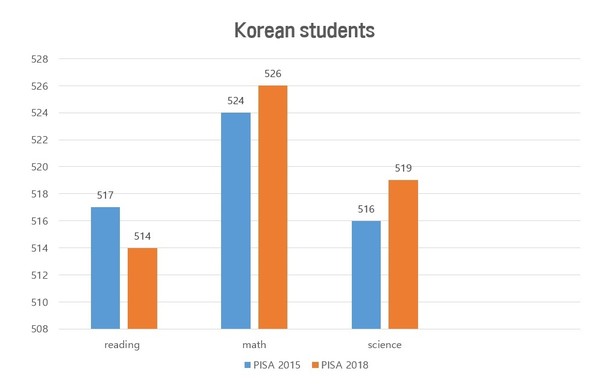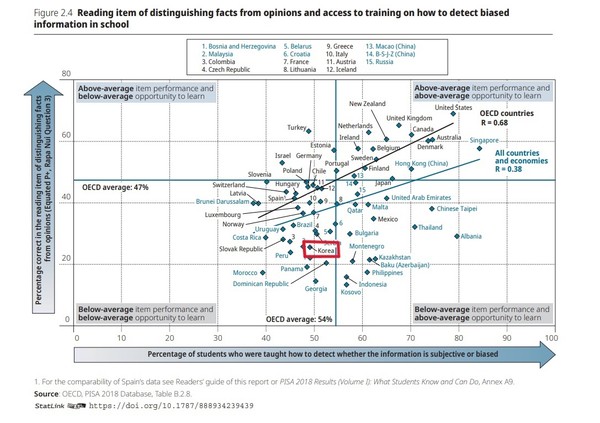"Teacher, what does 'definition' mean in this question?" This is a question a teacher receives when supervising a middle school exam. This student was unable to solve the problem because he did not know the meaning of Korean on the test paper.
An elementary school teacher said, "Students don’t even know easy words, so it's hard to move forward because I have to explain the meaning of many words in class. They know a new abbreviation (buzz word), but they don't know where the word originated. The reason why such a phenomenon occurs is that they encounter a lot of abbreviations online and make very little effort to understand precise meaning."
Like these, students’ literacy levels have dramatically decreased year by year. There are a number of students who do not know what it means even if they can read the letters and do not understand the problem.
Literacy of Korean student
Literacy plays an important role not only in school but also in daily life. Literacy refers to the ability to read and understand writing. Literacy has a broad meaning. UNESCO defines literacy as the ability to define, understand, interpret, create, communicate, and calculate using articles and publications related to various contexts (UNESCO, 2018). ‘Lower literacy’ is different from ‘illiterate’ that simply cannot read or write. If 'reading comprehension' is the ability to read and understand the meaning of the text, ‘Literacy’ is a concept that encompasses the ability to read and understand the text and express it in one's own way. Therefore, reading comprehension is a concept included in literacy. As we saw in the introduction, Korean students are suffering from this literacy. What is their level of literacy?

Reading, math, and science skills statistics conducted by the OECD in 2018 show that Korean students’ reading skills have decreased while math and science skills have increased compared to 2015. Reading ability is one of the elements of literacy.
Then, what do our students look like at school? According to a survey of 1,152 elementary, middle and high school teachers conducted by the Federation of Korean Teachers’ Associations, 4 out of 10 respondents said, ‘Students’ literacy levels are only 70 points (grade C).’ Teachers considered children’s too close access to electronic devices after the COVID-19 crisis as a reason for hindering literacy growth. Even before COVID-19, students’ reading and literacy were falling, but during the COVID-19 crisis, they fell even more significantly as they took classes with smartphones and tablet PCs. In particular, as students encounter social issues and articles through videos interpreted by others on YouTube, it is increasingly difficult to read the text and interpret what the content is. This decline in literacy not only affects students’ overall learning achievement, but also affects creativity, which is an essential competency in the future era.
What measures are Korean schools implementing in response to this problematic decline in literacy?
First, the 2015 revised curriculum presented learning contents such as ‘Critical reading, Expressing using media data (Korean),’ ‘Cyber etiquette (moral)’, ‘Cyber communication ethics (moral, information), ‘Popular culture and Mass media (society)’, ‘Visual culture and the medium of expression (art)’, ‘Privacy and Copyright Protection, algorithm (information).’ Accordingly, when students perform performing activities, they use media to search and collect necessary information or produce media content. In result, the ability to understand and organize texts can also increase.
Second, the Jeonnam Office of Education launched the nation’s first ‘A teacher system dedicated to basic education’ this year as students' literacy has decreased significantly due to the prolonged COVID-19. The ‘A teacher system dedicated to basic education’ means that teachers who have completed the ‘Keeping up with reading skills’ in-service training provided by the Office of Education teach one-on-one to students with weak literacy in a separate space during class. It supports literacy growth from the level of recognizing consonants and vowels to the level of reading and writing suitable for the developmental stage.
Finally, the Gwangju East and West Office of Education introduced the ‘An intensive class for basic education’ summer in 2022, and implemented it in the second semester of 2022. The main goal is to ensure a minimum academic background by providing intensive learning support to first and second graders of elementary school who have difficulty in literacy and mathematical skills.
Media literacy
Recently, media literacy is also one of the important concepts in education. First of all, The meaning of media literacy is the ability to critically analyze stories presented in the mass media and to determine their accuracy or credibility. The meaning of literacy is also changing with the trend of the times. In the 21st century, the concept of literacy is expanding to digital literacy critical literacy. In other words, it has become a world that requires the ability to express materials provided by digital technology. This means that the area and depth of literacy have been greatly expanded compared to the past. What literacy is needed in the digital generation? Media literacy basically requires the ability to distinguish facts and opinions.

OECD statistics show that Korean students' fact-opinion classification ability is lower than the average. In other words, the ability to understand and grasp the text, not just reading it, is poor. The following are statistics on the ability to identify facts and opinions and media literacy education in Korea. (International Academic Achievement Survey 2018 (PISA)) According to a report on digital literacy evaluation (PISA 2018) released by the OECD, only 25.6% of 15-year-old students in Korea can identify facts and opinions on the Internet. It is less than the OECD average of 47.7%. ‘Students who have received media literacy education’ was also 49%, lower than the OECD average (54%). This means that media literacy education is insufficient for Korean students.
Our view of literacy

Reading is the best way to improve literacy. We can improve concentration and contextualization through reading books. However, students who do not have reading habits are not only unfamiliar with books but also do not feel the need. As it is not a problem that can be solved in a short period of time, it is important to be interested in reading, speaking, and writing first. The literacy problem is a problem that not only individuals but also families, schools, communities, and the state should solve together.
To quote the book (Kim Sung-woo, Um Ki-ho), the indicator of literacy should not be how many points students received in the international academic achievement evaluation. More importantly, whether you have a literacy-related environment at home, have a chance to unfold your thoughts through conversations with your family, have a local library within walking distance, and have a librarian who can recommend books for you to read when you go to the library. In other words, what is important in literacy is how much reading, writing, and reflection are incorporated into everyday life. (p.134)
It is also necessary to approach the decline in literacy as a social problem, not an individual problem. As pre-service teachers, we should know the necessity of improving literacy and try to pay attention to students’ vocabulary and reading skills in school classes.
In addition, it should have a practical effect on students through direct classes, not temporary and theoretical classes. Efforts are needed through activities such as creating a poetry club where students can enjoy reading without any burden. In addition, the most important thing in digital literacy is the ability to critically analyze and understand the media.
There may be many ways to teach this, one of which is to analyze through the W5H1 principle. In other words, you can discuss with students how the principle of ‘who, when, where, what, how, and why’ appeared in the news article. Among them, ‘who’ often means a news source, so students can analyze which source was reported a lot in the news. Accordingly, if many stories of news sources supporting a particular position have been cited, the article can be criticized in terms of fairness of the news.
In addition, since news frames can have a great impact on news audiences, it is also necessary to see an article from various aspects so that you can look at the world without being trapped in the frame of news. For example, if article focuses on the damage caused by the war in Ukraine, it can be seen that the media is using a frame that informs the horrors of the war. On the other hand, if article intensively reports on the difficulties of the global economy caused by war, it can be seen that the media is using a frame that emphasizes the impact of war on the economy. In this way, students can realize firsthand that articles from various perspectives can come out from one topic even in activities, and they can go a step further with a wider perspective.
Literacy and digital literacy are important skills necessary for students in the future. So teachers that help them demonstrate their abilities well.

